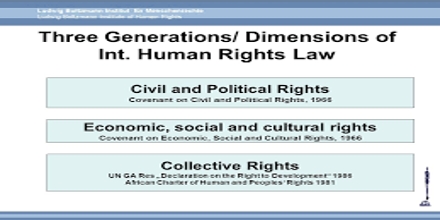Human Rights and Humanitarian Law: A Comparative Study
International Humanitarian Law is a new branch of international Law of which much has not yet been talked or written. However, now-a-days this subject is receiving keen attention from the academics in the west. The present study is an attempt to focus upon western contributions in this field. International Humanitarian law refers to international rules, whether of conventional or customary origin, that resulting from armed conflicts, international or otherwise. “These rules limit, for humanitarian reasons, the rights of the parties to the conflict to use methods and means of warfare purely of their own choice, and protect the persons and objects that are affected or may be affected by the conflict.”
The growth and expansion of international human rights law has brought about a radical change in the ideological bases of international law. Such a change is first evident in the universal acknowledgement that gross violations of individual and collective rights cannot be justified on grounds of sovereignty or demotic jurisdiction.
Introduction
Ever since the dawn of primitive society, human beings antagonized each other. War is a rot to humanity and involves most brutal and arbitrary violence’s. In all ages men have suffered under the sword and the yoke. Despite this, some norms or rules were developed the hoary past for the purpose of limiting the consequences of war and to protect men against the evils of war and arbitrary treatment. Jean Pictet who is recognized as the father of modern international Humanitarian law aptly says-
“The laws of war are as old as war itself and war is as old as life on the earth”
The laws of war are to be found in the leading religion, practices of warlords, writings of philosophers, customary rules of warfare and multilateral treaties concluded mostly in Geneva and the Hague in the 19th and 20th centuries.
But the stark reality shows that armed conflict still exist and claim an increasing number of victims in particular those who should remain immune under the law: the civilian population. To achieve better protection for those victims, IHL must be better known among those who should apply it: combatants, public officials and especially in the growing number of situations where structures of authority have disintegrated, the whole population.
International Humanitarian law
International Humanitarian law forms a major part of public International law and comprises the rules which in times of armed conflict, seek to protect persons who are not or are no longer taking part in the hostilities, and to restrict the methods and means of warfare employed, It is also called the law of armed conflict. Its traditional name was the law of war.
International Humanitarian law can be defined as the branch of international law limiting the use of violence in armed conflicts by:
- Sparing those who do not or no longer directly participate in hostilities;
- Limiting the violence to the amount necessary to achieve the aim of the conflict, which can be independently of the causes fought for only to weaken the military potential of the enemy.
According to Jean Pictet “Humanitarian law is that considerable portion of international law which is inspired by a feeling for humanity and is centred on the protection of the individual in time of war”
International Humanitarian law, which is an emergency law applicable in international or non- international armed conflict, is a branch of International law. Now-a-days this subject is receiving keen attention from all epochs. There is an increasing number of writing and analysis on International Humanitarian law. Recently, several excellent text books on that matter have been published in different languages. Now the present study is a little attempt to enlighten the discussion on the development of IHL, and to enhance the international humanitarian assistance in the continuance of armed conflict or war devastated economy. It is pertinent to mention here that International Humanitarian law is omnipresent in contemporary conflict. But the provisions of humanitarian conventions (mainly Geneva) have no relevance in the contemporary crisis, rather than there is the practice of belligerency in Kosovo, Bosnia, Chechnya, Liberia, Sierra Leone and glaring example of Afghanistan and Iraq. Their (humanitarian convention) effectiveness or implementation is a dismal failure. So, the aims of my research and analysis is to elucidate the framework of International Humanitarian law, to establish the legal relationship between International Humanitarian law and International; law of Human rights and to point out the evolution and development of International Humanitarian law and finally to evaluate the role played by the ICRC in the implementation of International Humanitarian law. So, I would like to say that prior to any operation in the name of international co-operation it should comply with International Humanitarian law just to lessen the humanitarian catastrophe and to deliver abrupt humanitarian assistance.
Basic Principles of International Humanitarian law
International Humanitarian law has in particular universal vocation, since it applies to men and countries. The humanitarian principles are common to all human communities whenever they may be. The main object of IHL is to regulate hostilities in order to attenuate their hardships and protect the civilian from the curse of armed conflict. Humanitarian law has two branches, one bearing the name of Geneva and the other the name of The Hague. The basic principles of IHL are as follows:
i) The distinction between civilians and combatants;
ii) The prohibition to attack those hors de-combat;
iii) The prohibition to launch attacks against the civilian;
iv) The prohibition to inflict unnecessary suffering;
v) Protections of the prisoners of war;
vi) The principle of necessity;
vii) Protection of the wounded, sick and shipwrecked persons;
viii) The principle of proportionality;
Development of International Humanitarian Law
The development of IHL is not really a subject of today, if we look back to the ancient period, it will be evident that the ancient civilization particularly Greek and Roman Civilization played a very significant role in the development of International Humanitarian Law. In this period International Humanitarian Law was developed through some stages.
In the ancient period during the continuance of war people maintained various categories of rules which were similar to modern international rules of war: rules distinguishing types of enemies, rules defining the circumstances, formalities and authority for beginning, rules describing limitations of persons, time place, and methods etc. The great Genghis Khan was famous for his powerful and successful army. Genghis Khan was also famous for his ruthless efficiency in battle, or quite simply, his ruthlessness. In the ancient period various categories of nations maintained their respective rules during the war time. It is elaborated below:
Grotius did not abandon the idea of the just war, but considered that the inherent competence of the state to wage war was a more important element in war than the justice of its causes and regarded was as one of the means of conserving the state. In his famous treatise De jure belli ac pacis he wrote, “In war we must always have peace in mind” He was the first to assert that the “Just cause” invoked by a state to resort to war did not negate the duty of the belligerents to observe the laws of war. Grotius believed that the population of an adverse country was an enemy, at the mercy of the winner. At the same time he insisted that violence beyond what was necessary for victory was not justified. Since violence is no longer regarded as the administration of punishment, it ceases to be an end in itself; it becomes a means, to be used with increasing and measured moderation.In his major work, De jure belli ac pacis, which the Catholic Church kept on the index of forbidden books until 1899, Grotius enumerated the Temperament belli which constitute part of the most solid foundations of the law of war.
Development of scientific Spirit and Humanization of War:
The 17th century opened the age of enlightenment which among other things witnessed the birth of humanization, an advanced and rational form of charity and justice. The philosophers refused to consider suffering as a fatality and no longer accepted the doctrine that every man was responsible for the misery in the world. They held that all men had equal and inalienable rights, which it was the responsibility of the states to guarantee.
In the 18th century war became a struggle between professional armies with smaller numbers of soldiers. Civilians were no longer directly involved, because the armies had their own supply services & pillage was forbidden, war was, in short, under human control. The humanization of war proceeded rapidly at least in Europe. In 1875s, ‘Treaty of Friendship and Peace’ was arrived at by Frederick the Great and Benjamin Franklin.
The recurrence of comparable clauses created a veritable customary law which may be summed up as follows:
Hospitals shall be immunized and be marked by special flags with identifying colours for each army.
The wounded and sick shall not be regarded as province of war, they shall be cared for like the soldiers of the army which captured them and sent home after they are cured.
- Doctors & their assistants and Chaplains shall not be taken as captives & shall be returned to their own side.
- The lives of prisoners of war shall be protected and they shall be exchanged without ransom.
- The peaceful civilian population shall not be molested.
Foundation of the Red Cross:
The horrendous situation had hardly improved by the beginning of the second half of the 19th century. Following the siege of Messina in 1848, Doctor Palasciano, one of the precursors of the Red Cross, having barely escaped the death penalty, was sentenced to one year in prison for bandaging the wounds of the defeated garrison. When the Crimean War broke out in 1854, the medical service of the Franco-British expeditionary corps was virtually non-existent. Of the 3, 00,000 men in this army 83, 00 died of diseases in unspeakable conditions of disaster and distress, Mortality among the amputees was 72 percent. It took the prodigious energy and devotion of Florence Nightingale, a 26 year old English woman, the toll of death and misery. In the concourse of the conflict all the customary principles of humanitarian law had fallen by the wayside.
From the above it is evident that the International Committee of the Red Cross was established at the latter part of the 19th century, which was a great milestone in the history of human civilization. This institution, though national in composition but international in character and activity, was the product of the endeavour of a great man Henry Dunant to whom the world owes too much for his services to mankind.
Human Rights
Human rights refer to the “basic rights and freedoms to which all humans are entitled.” Examples of rights and freedoms which have come to be commonly thought of as human rights include civil and political rights, such as the right to life and liberty, freedom of expression, and equality before the law; and economic, social and cultural rights, including the right to participate in culture, the right to food, the right to work, and the right to education.
Historical Development of Human Rights
Several ancient documents and later religions and philosophies included a variety of concepts that may be considered to be human rights. Notable among such documents are the Edicts of Ashoka issued by Ashoka the Great of India between 272-231 BC; and the Constitution of Medina of 622 AD, drafted by prophet Muhammad to mark a formal agreement between all of the significant tribes and families of Yathrib (later known as Medina), including Muslims, Jews and Pagans. The English Magna Carta of 1215 is particularly significant in the history of English law, and is hence significant in international law and constitutional law today.
Much of modern human rights law and the basis of most modern interpretations of human rights can be traced back to relatively recent history. The Twelve Articles of the Black Forest (1525) are considered to be the first record of human rights in Europe. They were part of the peasants’ demands raised towards the Swabian League in the Peasants’ War in Germany. The British Bill of Rights (or “An Act Declaring the Rights and Liberties of the Subject and Settling the Succession of the Crown”) of 1689 made illegal a range of oppressive governmental actions in the United Kingdom. Two major revolutions occurred during the 18th century, in the United States (1776) and in France (1789), leading to the adoption of the United States Declaration of Independence and the French Declaration of the Rights of Man and of the Citizen respectively, both of which established certain legal rights. Additionally, the Virginia Declaration of Rights of 1776 encoded a number of fundamental rights and freedoms into law.
The Charter does not establish any particular of human rights protection and the emphasis is upon the non-intervention in the affairs of member States of the United Nations. These were followed by developments in philosophy of human rights by philosophers such as Thomas Paine, John Stuart Mill and G. W. F. Hegel during the 18th and 19th centuries. The term human rights probably came into use sometime between Paine’s The Rights of Man and William Lloyd Garrison’s 1831 writings in The Liberator saying he was trying to enlist his readers in “the great cause of human rights”.
Many groups and movements have managed to achieve profound social changes over the course of the 20th century in the name of human rights. In Western Europe and North America, labour unions brought about laws granting workers the right to strike, establishing minimum work conditions and forbidding or regulating child labour. The women’s rights movement succeeded in gaining for many women the right to vote. National liberation movements in many countries succeeded in driving out colonial powers. One of the most influential was Mahatma Gandhi’s movement to free his native India from British rule. Movements by long-oppressed racial and religious minorities succeeded in many parts of the world, among them the civil rights movement, and more recent diverse identity politics movements, on behalf of women and minorities in the United States.
The establishment of the International Committee of the Red Cross, the 1864 Lieber Code and the first of the Geneva Conventions in 1864 laid the foundations of International humanitarian law, to be further developed following the two World Wars.
The World Wars, and the huge losses of life and gross abuses of human rights that took place during them were a driving force behind the development of modern human rights instruments. The League of Nations was established in 1919 at the negotiations over the Treaty of Versailles following the end of World War I. The League’s goals included disarmament, preventing war through collective security, settling disputes between countries through negotiation, diplomacy and improving global welfare. Enshrined in its Charter was a mandate to promote many of the rights which were later included in the Universal Declaration of Human Rights.
At the 1945 Yalta Conference, the Allied Powers agreed to create a new body to supplant the League’s role. This body was to be the United Nations. The United Nations has played an important role in international human rights law since its creation. Following the World Wars the United Nations and its members developed much of the discourse and the bodies of law which now make up international humanitarian law and international human rights law.
Universal Declaration of Human Rights:
The Universal Declaration of Human Rights (UDHR) is a non-binding declaration adopted by the United Nations General Assembly in 1948, partly in response to the atrocities of World War II. Although the UDHR is a non-binding resolution, it is now considered to be a central component of international customary law which may be invoked under appropriate circumstances by national and other judiciaries. The UDHR urges member nations to promote a number of human, civil, economic and social rights, asserting these rights are part of the “foundation of freedom, justice and peace in the world.” The declaration was the first international legal effort to limit the behaviour of states and press upon them duties to their citizens following the model of the rights-duty duality.
The UDHR was framed by members of the Human Rights Commission, with former First Lady Eleanor Roosevelt as Chair, who began to discuss an International Bill of Rights in 1947. The members of the Commission did not immediately agree on the form of such a bill of rights, and whether, or how, it should be enforced. The Commission proceeded to frame the UDHR and accompanying treaties, but the UDHR quickly became the priority.[9] Canadian law professor John Humprey and French lawyer René Cassin were responsible for much of the cross-national research and the structure of the document respectively, where the articles of the declaration were interpretative of the general principle of the preamble. The document was structured by Cassin to include the basic principles of dignity, liberty, equality and brotherhood in the first two articles, followed successively by rights pertaining to individuals; rights of individuals in relation to each other and to groups; spiritual, public and political rights; and economic, social and cultural rights. The final three articles place, according to Cassin, rights in the context of limits, duties and the social and political order in which they are to be realized. Humphrey and Cassin intended the rights in the UDHR to be legally enforceable through some means, as is reflected in the third clause of the preamble:
Treaties
In 1966, the International Covenant on Civil and Political Rights (ICCPR) and the International Covenant on Economic, Social and Cultural Rights (ICESCR) were adopted by the United Nations, between them making the rights contained in the UDHR binding on all states that have signed this treaty, creating human rights law.
Since then numerous other treaties (pieces of legislation) have been offered at the international level. They are generally known as human rights instruments. Some of the most significant are:
- Convention on the Elimination of All Forms of Racial Discrimination (CERD) (adopted 1966, entry into force: 1969)
- Convention on the Elimination of All Forms of Discrimination Against Women (CEDAW) (entry into force: 1981)
- United Nations Convention Against Torture (CAT) (adopted 1984, entry into force: 1984)
- Convention on the Rights of the Child (CRC) (adopted 1989, entry into force: 1989)
- International Convention on the Protection of the Rights of All Migrant Workers and Members of their Families (ICRMW) (adopted 1990, entry into force: 2003)
Comparative Studies
Both international humanitarian law (IHL) and international human rights law (IHRL) strive to protect the lives, health and dignity of individuals, albeit from a different angle. It is therefore not surprising that, while very different in formulation, the essence of some of the rules is similar, if not identical. For example, the two bodies of law aim to protect human life, prohibit torture or cruel treatment, prescribe basic rights for persons subject to a criminal justice process, prohibit discrimination, comprise provisions for the protection of women and children, and regulate aspects of the right to food and health. On the other hand, rules of IHL deal with many issues those are outside the purview of IHRL, such as the conduct of hostilities, combatant and prisoner of war status and the protection of the Red Cross and Red Crescent emblems. Similarly, IHRL deals with aspects of life in peacetime that are not regulated by IHL, such as freedom of the press, the right to assembly, to vote and to strike.
Today there can no longer be any dubiety; international humanitarian law and international human rights law are near relation. This off-repeated observation must now be accepted by al1l. Many believe that the close relationship between those two existed and was perceived “from the outset”. The relationship between humanitarian law and human rights are elaborated.
The term ‘IHL’ is a relatively new term of international law which applied to those rules of int’l law with an aim to protect persons suffering from the evils of armed conflicts.
In the early 1950s the ICRC first used the term to denote the law of Geneva Convention which previously had been considered simply a part of the law.
The term humanitarian law was first proposed by Jean Pictet who is recognized as the father of Modern International Humanitarian Law.
According to him “Humanitarian law is that considerable portion of international law which is inspired by a feeling for humanity and is centered on the protection of the individual in time of war”.
International Humanitarian Law is based on the norms of international laws rather than national constitutions and municipal laws. It refers to int’l rules, whether of conventional or customary origin, that are specifically designed to resolve humanitarian problems resulting from armed conflicts international or otherwise. The historical development of International Humanitarian Law shows that it is consisted of convention, declarations, regulations etc. adopted mainly in Geneva and The Hague. Modern International Humanitarian Law is embodied primarily in the four Geneva Convention of 1949 and two Protocols of 1977 and in rules of customary law.
In contrast, Human rights, which were typically called the rights of man or natural rights, are those rights which are universally inherent inviolable and inalienable rights of all members of human family which primarily the state are to ensure to their citizen by providing a well defined procedure.
Thomas Paine may have been the first to use the term human rights, in his English translation of the French Declaration of the Rights of Man adopted by the national Assembly of France in 1789 which prefaced the constitution of 1791.
The idea of human rights to a great extent evolved as a result of political absolutism since rights of man became a slogan against the injustices and indignities committed by tyrannical or despotic governments. It was developed as a part of the constitutional law of the individual states. The classic doctrine of international law had no place for human rights at all.
According to Oppenheim, “the so-called rights of man cannot enjoy any protection under international law, because that law is concerned solely with the relations between states and cannot confer rights on individuals”.
Human rights primarily concerned relation between states and their own nations, an area “traditionally regarded as a domestic matter”. Human rights, in fact, did not enter the field of international law until the end of World War II. The atrocities committed during that war served as the catalyst for international concern for human rights and radically changed the theory and practice of the law of nations. Thus, international concern with human rights is a contemporary development, dating largely from the Second World War.
Official link between Human Rights and Humanitarian Law:
Despite the keen interest in international guarantee of human rights in the years following World War II, no connection between human rights and humanitarian law was recognized for many years. The Universal Declaration of Human Rights 1948 or the European Convention for the protection of Human Rights and Fundamental Freedoms, 1950 does not refer to the rights of enemy nationals in time of war. The UN int’l law commission in 1949 decided not to include the law war among the subject of its concern.
Not until 1981 was a link officially established between human rights and humanitarian law the international conference on human right, convened by the United Nations at Teheran adopted a resolution that called for meaningful application of further agreements.Under the title human rights in Armed conflict the resolution initiated UN action on humanitarian law. Although the United Nations spoke of human rights, it meant humanitarian law. It is thus, seen that “humanitarian law is coming to be recognized as the particular branch of human rights law which relates to human rights in times of armed conflict”.
The relationship between these two branches of international law became particularly obvious in the war of national liberation. People encased in such was fought for self- determination, which is recognized as a human right in the international conversions, and for recognition as a party to an international armed conflict to which humanitarian law is applicable. Thus “attempts at self-determination trigger both human rights and humanitarian law questions “.
Impact of Human Rights on Humanitarian law:
Human rights conventions have influenced humanitarian law, but the converse has not been true. The influence of the Universal Declaration of Human Rights, 1948, the four Genera Conventions of 1949 is apparent. The strongest impact of human rights conventions on humanitarian law however may be seen in the two protocols of 1977, which supplemented the conventions of 1949. Several provisions in the two Protocols of 1977 are dirty derived from the ICCPR, 1966 particularly article 75 of Protocol I and article 4& 6 of Protocol II.
The convergence of humanitarian law and human rights those that war and peace, civil war and international war as well as international law and domestic law are increasingly intertwined. Consequently, the law of war and the law of peace, as well as humanitarian law and human rights, which were originally clearly distinct in scope, are now often applicable simultaneously.
Respective fields of application:
The humanitarian conventions are applicable in armed conflicts. The conventions protect persons of enemy nationality, or in the case of internal armed conflict, members of the opposition parties within the country. The object of International Humanitarian Law is to regulate hostilities in order to attenuate their hardships.
International Humanitarian Law includes international legal settlement of armed conflicts and protection of their victims, because in all cases when armed conflicts break out, the object of the international law community should be their utmost humanization, termination and provision of assistance to the victims. In pursuing this policy the international law community has worked out the Geneva Convention for the protections of war victims and Protocols Additional to these conventions. (1977).
On the other hand, human rights conventions however, in principal apply during peacetime as well as in armed conflicts and persons within the Jurisdiction of a state. In actual practice the Human Rights conventions have a very limited application to armed conflicts. Human Rights Conventions contain clauses permitting the ratifying states to derogate their obligations in times of public emergency on war. In most armed conflicts, therefore, the majority of human rights may be suspended.
Substantive Rights:
A comparison of the substantive rights guaranteed by humanitarian law and by human rights conventions results in three categories of rights.
Firstly, some rights are common to both human rights and humanitarian law. Among these rights are the prohibitions of violence to the life, health or physical or mental well being of persons, torture and other inhuman treatment and the guarantees of a fair judicial procedure in the case of penal prosecution.
Secondly, there are some rights which are specific to the human rights conventions but that have no relevance to armed conflicts. Among these rights are the economic, social and cultural guarantees of the International Covenant on Economic social liberties such as the freedom of expression and association, the right to marry etc.
Thirdly, there are some rights which are specific to the humanitarian Law (Conventions) but applicable in armed conflict, these rights are intended to protect the wounded and a sick member of the armed forces, prisoners of wars, civilian internees and other persons.
Thus, the substantive rights guaranteed by humanitarian law and human rights conventions demonstrate similarities and dissimilarities between humanitarian law and human rights law.
Enforcement mechanism:
The enforcement mechanism of human rights and humanitarian law are different in nature. Human rights may be enforced by the international Law tribunal provided the domestic remedies have been exhausted. For this complaints to be made by a contracting party or by the individuals whose rights have been infringed.
On the other hand, humanitarian law may be protected through the protecting power and / or the ICRC. Only in few cases it can be enforced by the judicial authority.
Status under international legal system:
The relationship between international Humanitarian Law and Human Rights in International Law are obscure and will probably remain a matter of controversy for some time. Several jurists have offered proposals to alleviate this problem. There are three views in this regard-
According to Pictet “International Humanitarian Law should comprise both human rights and humanitarian Law,” But his agreements can not be accepted on the ground that International Humanitarian Law is used for Law of armed conflict and not for human rights.
According to A.H. Robertson, ” Humanitarian Law is one branch of the Law of Human Rights, and human rights afford the basis for humanitarian Law” Similarly G.I.A.D. Draper considered humanitarian Law as a regime of human rights adapted to the particular needs of armed conflicts.
There is another view which is opposite to that mentioned above. According to this view, humanitarian Law and human rights regulate different subjects and are of a different nature. In Henry Meyrowitz’s opinion, the ideological controversies existing with regard to human rights confusing humanitarian law with human rights is dangerous for humanitarian law.
The Philosophy of Humanitarian law and human rights:
International Humanitarian Law is increasingly perceived as part of human rights applicable in armed conflict. It was developed at a time when recourse to force was not illegal as an instrument of national policy. Although it is true that one of the influences on the development of the law in Europe was the church just war doctrine, which also encompassed the justice resorting to force the foundations of international Humanitarian Law were laid at a time when there was no disgrace in beginning a war. The law was therefore, in large part based on the appropriate respect that was due to another professional army. We will here as a good illustration of the philosophy underlying the customary law of the war the Lieber Code of as this Code was used as the principal basis for development of the Hague Conventions of 1899 an 1907 which in turn influenced later development.
The relevance of war being a lawful activity at the time is reflected in Art.67 of the Lieber Code:
“The law of nations allows every sovereign govt. to make war upon another sovereign state, and there are admits of no rules or laws different from those of regular warfare, regarding the treatment of prisoners of war, although they may belong to the army of a govt. which the captor army consider as a wanton and unjust assailant.”
The Lieber Code was regarded at the time as generally reflecting customary law although in places it particularly stressed the importance of respecting humanitarian treatment which, in practice was not always accorded.
Unlike human rights law, however, there is no concept of derogation in humanitarian law. Derogation in human rights is allowed in most general treaties in times of war or other emergency threatening the life of the nation. Humanitarian law is precisely for those situations, and he rules are fashioned in a manner that will not undermine the ability of the army in questions win the war.
International Humanitarian Law indicates how a party to a conflict is to behave in relation to people at its mercy, where human rights law are concentrates on the rights of the recipients of a certain treatment. In the appearance of the treaty International Humanitarian law seems long and complies where as human rights treaties one comparatively short and simple.
Conceptual similarities are present day between humanitarian rights law:
Having looked at the origins and formulation of these two areas of law, we can now turn to their present method o inter perdition and implementation. The most important change as far as humanitarian law is concerned is the fact that recourse to war is not longer a legal means of regulating conflict. In general humanitarian law is how less perceived as a code of honour for combatants than as a means of sparing non- combatants as much as possible from the horrors of war. From a purist human rights point o view, based as it is on respect for human life and well being the use of force is in itself a violation of human rights. This was indeed stated at the 1968 Human rights conference in Tehran as follows:
“Peace is the underlying condition the full observance of human rights and war is their negation.”
The most important general observation to be made is thud like human rights law, humanitarian law is based on the premise that the protection accorded to victims of war must be without any discrimination. This is such a fundamental rule of human rights that it is specified not only in the UN charter but also in all human rights treaties. One of many examples is humanitarian law is Art. 97 of the fourth Geneva Convention of 1949:
“all protected persons shall be treated with the same consideration by the party to the conflict in whose power they are, without any adverse distinctions based, in particular or race, religion on political opinion.”
The mutual influence of human rights and Humanitarian Law:
There are two kinds of reasons for the almost total independence of International Humanitarian Law rights law immediately after the World War II. The first relate to the genesis and development of the branches concerned. However, their present convergence, as described earlier, makes the establishment of certain closer links between two legal domains conceivable.
In the connection, Art. 3 common to the four Geneva Conventions is revealing. Miniature treaty within the Conventions Common Art.3 lays down the basic rules which states are required to respect when confronted with armed groups on their own territory. It thus humanitarian law which in principle, did not between itself with the relations between a state and it’s nationally. The true turning point when International Humanitarian Law and human rights gradually began to draw closer came in 1968 during the International conference on Human Rights in Teheran, at which the UN for the first time considered the application of human rights in armed conflict. The interlinking of human rights and humanitarian law can also be seen in the work of bodies responsible for monitoring and implementation international law.
In the connection it is interesting to not that in recent years the Security Council has been citing humanitarian law more and more frequently in support of its resolutions. The latest example of this tendency can be found in Resolution (1993) on the conflict in the former Yugoslavia, in international tribunal for the prosecution of persons responsible for serious violations of International Humanitarian Law committed in the territory of the former Yugoslavia since 1991.”
A body more specifically concerned with the implementation of human rights the commission an Human Rights, likewise no longer hesitates to invoke humanitarian law to back up its recommendations. The report on the situation of human rights in Kuwait under Iraqi Occupation at its 48th session is a clear example.
Conclusion:
Eventually, before concluding our discussion we can say that International Humanitarian law was conceived and developed gradually through ancient period, middle period and a greater extent during modern period. Although Human rights and humanitarian law have totally different historical origins, it is resultantly coincided and has influenced each other in recent developments. Both the human rights and humanitarian law now have a much greater international profile and are regularly being used together in the work of both international and non governmental organizations. There can be no doubt that the growing prominence of human rights law in recent decades is largely due to the activism of non-governmental human rights organizations. Several have now begun to use humanitarian law in their work and may well exert a considerable influence in the future, and it is to be hoped that continued recognition of the specific nature of humanitarian law, together with the various energies devoted to implementation of human right law, will have the effect of enhancing the protection of the person in situations of violence. Despite some justifications between humanitarian law and human rights, it is not entirely satisfactory, Human rights and humanitarian law are satisfactorily described as independent parts of international law, with common aims, some common principles and overlapping areas of concern and effect. This is the prudent approach which demarcates the status of human rights and humanitarian law under the international legal system.
















